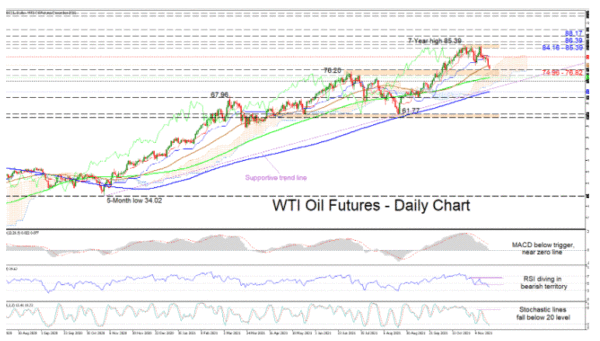WTI oil futures have logged a minor correction from the fresh 7-year high levels, dipping slightly beneath the 50-day simple moving average (SMA) at 78.38, and nearing the Ichimoku cloud. That said, the longer-term 100- and 200-day SMAs continue to endorse the positive structure.
The Ichimoku lines are indicating a modest loss of power in the upward drive, while the short-term oscillators are suggesting negative momentum is gaining pace. The MACD is falling beneath its red trigger line and has reached the zero threshold. Moreover, the RSI is diving in the bearish region, while the stochastic lines have dipped into oversold territory.
If the current price trajectory holds, the nearby support border of 74.96-76.82 – coupled with the cloud’s upper band – may test sellers’ efforts to push lower. Should this upside defence fail to provide the necessary footing for the price, the 100-day SMA at 74.25 and the 73.00 handle could then step into the spotlight. From here, a deeper pullback stretching underneath the cloud may meet a promising supportive trendline, pulled from the five-month low of 34.02, before targeting the 200-day SMA at 69.39.
Otherwise, if buyers form a foothold off the cloud and the 74.96-76.82 support and push back above the 50-day SMA at 78.38, the next upside constraint could evolve around the Ichimoku lines at 81.16. Overstepping them, the price may then challenge the highs existing in the 84.16-85.39 area, associated with levels last seen 7-years ago. Surpassing this zone, the bulls could then hit the 86.39 barrier before pushing for the 88.17 mark, identified in the early part of October 2014.
Summarizing, in the short-term timeframe, WTI oil futures are sustaining a bullish bias above the 61.77 trough. For negative worries to grow, the price would need to dive below the cloud and the 200-day SMA.













